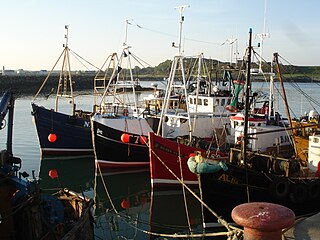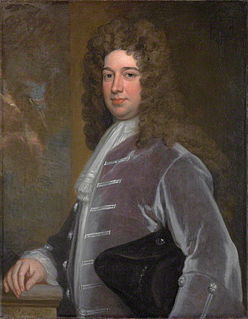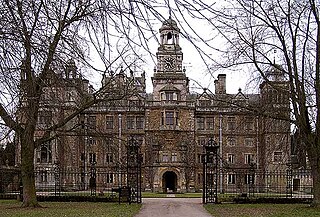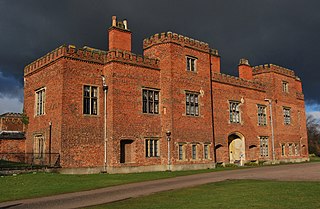
Baron Pierrepont is a title that has been created four times in British history. The first creation came in the Peerage of England on 29 June 1627 when Sir Robert Pierrepont was created Baron Pierrepont, also being created Viscount Newark at the same time. He was further created Earl of Kingston-upon-Hull in 1628. The fifth Earl was created Duke of Kingston-upon-Hull in 1715 in the Peerage of Great Britain, with the Dukedom becoming extinct on the death of the second Duke in 1773.
The Peerage of England comprises all peerages created in the Kingdom of England before the Act of Union in 1707. In that year, the Peerages of England and Scotland were replaced by one Peerage of Great Britain.

Robert Pierrepont, 1st Earl of Kingston-upon-Hull was an English nobleman who joined the Royalist side in the English Civil War after some delay and became lieutenant-general of the counties of Lincoln, Rutland, Huntingdon, Cambridge and Norfolk. He was killed in a friendly fire incident after being captured by Parliamentary forces.

Duke of Kingston-upon-Hull was a title in the Peerage of Great Britain, with the title Earl of Kingston-upon-Hull being a title in the Peerage of England. The Earldom was created on 25 July 1628 for Robert Pierrepont, 1st Viscount Newark. The Dukedom was created on 10 August 1715 for his great-grandson, Evelyn Pierrepont, 1st Marquess of Dorchester, who had succeeded as the fifth Earl of Kingston-upon-Hull in 1690. The Dukedom became extinct on the death of the second Duke in 1773. These titles are often informally shortened to the Duke of Kingston, and should not be confused with the separate Irish title, Earl of Kingston.
Contents
- Barons Pierrepont; first creation (1627)
- Baron Pierrepont, of Ardglass, and of Hanslope; second and third creations (1702 and 1714)
- Barons Pierrepont, of Holme Pierrepont; fourth creation (1796)
- References
The second creation came in the Peerage of Ireland on 29 March 1702 when Gervase Pierrepont was created Baron Pierrepont, of Ardglass, County Down. On 19 October 1714 he was also made Baron Pierrepont, of Hanslope in the County of Buckingham, in the Peerage of Great Britain, being the third creation of the title, with this creation giving Gervase Pierrepont an automatic seat in the House of Lords. He was the third son of the Honourable William Pierrepont, second son of Robert Pierrepont, 1st Earl of Kingston-upon-Hull. The titles became extinct on his death on 22 May 1715.
The Peerage of Ireland consists of those titles of nobility created by the English monarchs in their capacity as Lord or King of Ireland, or later by monarchs of the United Kingdom of Great Britain and Ireland. The creation of such titles came to an end in the 19th century. The ranks of the Irish peerage are Duke, Marquess, Earl, Viscount and Baron. As of 2016, there were 135 titles in the Peerage of Ireland extant: two dukedoms, ten marquessates, 43 earldoms, 28 viscountcies, and 52 baronies. The Crown of the United Kingdom of Great Britain & Northern Ireland continues to exercise jurisdiction over the Peerage of Ireland, including those peers whose titles derive from places located in what is now the Republic of Ireland. Article 40.2 of the Irish Constitution forbids the state conferring titles of nobility and a citizen may not accept titles of nobility or honour except with the prior approval of the Government. As stated above, this issue does not arise in respect of the Peerage of Ireland, as no creations of titles in it have been made since the Constitution came into force.
Gervase Pierrepont, 1st Baron Pierrepont, was an English politician.

Ardglass is a coastal fishing village, townland and civil parish in County Down, Northern Ireland, in the historic barony of Lecale Lower. It is still a relatively important fishing harbour. It is situated on the B1 Ardglass to Downpatrick road, about 6 miles to the south east of Downpatrick, in the Lecale peninsula on the Irish Sea. It had a population of 1,668 in the 2001 Census, and is located within the Newry, Mourne and Down area.
The fourth creation came in the Peerage of Great Britain on 23 July 1796 when Charles Pierrepont was made Baron Pierrepont, of Holme Pierrepont in the County of Nottingham. He was made Viscount Newark, of Newark on Trent, at the same time. Born Charles Medows, he was the son of Philip Medows and Lady Frances, daughter of William Pierrepont, Earl of Kingston, eldest son and heir apparent of Evelyn Pierrepont, 1st Duke of Kingston-upon-Hull. In 1788 he succeeded to the Pierrepont estates and assumed by Royal sign manual the same year the surname of Pierrepont in lieu of Medows. In 1806 he was further honoured when he was created Earl Manvers. All these titles became extinct on the death of the sixth Earl Manvers in 1955.

Charles (Medows) Pierrepont, 1st Earl Manvers was a British naval officer and politician who sat in the House of Commons from 1778 to 1796 when he was raised to the peerage as Viscount Newark.

Evelyn Pierrepont, 1st Duke of Kingston-upon-Hull was an English aristocrat.

Earl Manvers was a title in the Peerage of the United Kingdom. It was created in 1806 for Charles Medows Pierrepont, 1st Viscount Newark. He had already been created Baron Pierrepont, of Holme Pierrepont in the County of Nottingham, and Viscount Newark, of Newark-on-Trent in the County of Nottingham, in 1796. Both these titles were in the Peerage of Great Britain. Born Charles Medows, he was the second son of Philip Medows, Deputy Ranger of Richmond Park, by Lady Frances Pierrepont, daughter of William Pierrepont, Earl of Kingston (1692–1713), eldest son and heir apparent of Evelyn Pierrepont, 1st Duke of Kingston-upon-Hull.








